英汉互译简明教程TranslationTechniques ppt课件
合集下载
英汉互译简明教程(第二版)课件3 第一篇 主语显著和话题显著
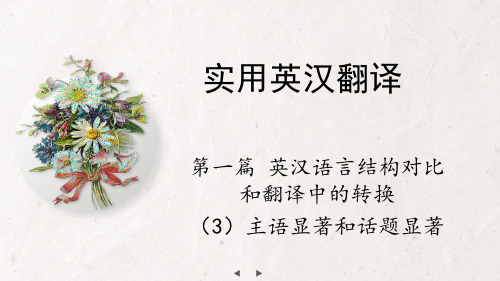
她举止文雅,面有雀斑,满头红发,像个小女孩那么 可爱,但走在街上引不起多少人注意。
翻译中的转换 E-C:英语“主谓结构”转为汉语 “话题-评论”结构
练习
Sport and physical education are activities undertaken in mankind’s ceaseless pursuit of the Olympic ideal. Sport not only builds one’s physique, but also teaches communication, cooperation, respect for others, and acceptance of failure. As such, it is an important medium for strengthening the ties among different civilizations and values.
责任制度,条件成熟时就实行。
翻译中的转换 E-C:英语“主谓结构”转为汉语 “话题-评论”结构
长句翻译注意事项: – 英语原文由复合句组成,具有多个主谓结构。 – 汉语句子通常在句首点出话题,且话题在句中起着 统领作用。汉语句子可以在主语出现一次之后,或 在具有同一逻辑主语时,借来能出现数个谓语结构, 形成由若干小句形成的流水句。
例1:凡是已经发现的错误,我们都已经采取了或正在采取 纠正的步骤。没有发现的,已经发现,我们就准备纠正。
译文1:We are taking or have taken steps to correct all the mistakes discovered, and we are ready to correct those not yet discovered as soon as they come to light.
翻译中的转换 E-C:英语“主谓结构”转为汉语 “话题-评论”结构
练习
Sport and physical education are activities undertaken in mankind’s ceaseless pursuit of the Olympic ideal. Sport not only builds one’s physique, but also teaches communication, cooperation, respect for others, and acceptance of failure. As such, it is an important medium for strengthening the ties among different civilizations and values.
责任制度,条件成熟时就实行。
翻译中的转换 E-C:英语“主谓结构”转为汉语 “话题-评论”结构
长句翻译注意事项: – 英语原文由复合句组成,具有多个主谓结构。 – 汉语句子通常在句首点出话题,且话题在句中起着 统领作用。汉语句子可以在主语出现一次之后,或 在具有同一逻辑主语时,借来能出现数个谓语结构, 形成由若干小句形成的流水句。
例1:凡是已经发现的错误,我们都已经采取了或正在采取 纠正的步骤。没有发现的,已经发现,我们就准备纠正。
译文1:We are taking or have taken steps to correct all the mistakes discovered, and we are ready to correct those not yet discovered as soon as they come to light.
英汉互译简明教程(第二版)课件8 第二篇 长句翻译
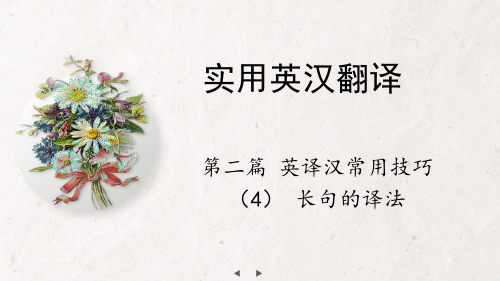
译文:由于人民生活水平的不断提高以及计划生育,中国的家庭
3
结构发生这缓慢却又具有实质性的变化,必须根据这一历史背景
2
1
考虑人到老年的问题。
11
变序法
3. I consider a human soul without education, like marble in the quarry, which shows none of its inherent beauties, until the skill of the polisher fetches out the colors, makes the surface shine, and discovers every ornamental cloud, spot and vein that runs through the body. (P109)
15
分句法
6. Having just left school or technical institute, where they had their place and a task to fulfill and where they were known and esteemed by their colleagues, those young people who do not land that first job they were so eagerly looking forward to have to face up for the first time to unemployment, a situation for which neither family nor school has prepared them. (P111-112)
新英汉翻译课件教程Chapter-5-翻译的技巧

被动语态的处理:根据中文原句的语态,选择合适的被动语态或主动语态进行翻译
主被动转换的处理:在中文原句中没有明显的主被动关系时,需要根据英文表达习惯 进行主被动转换
时态的处理:根据中文原句的时间信息,选择合适的英文时态进行翻译
人称代词的处理:在中文原句中的人称代词需要根据英文表达习惯进行转换,以避免 歧义或不符合英文语法的情况
Part One
单击添加章节标题
Part Two
翻译的基本技巧
选词准确
理解原文:准确理 解原文中的词汇和 短语,确保翻译的 准确性
查阅词典:查阅相 关词典,了解词汇 的准确含义和用法
选词技巧:根据语 境和搭配选择合适 的词汇,避免使用 生僻词汇或过于口 语化的表达
校对译文:校对译 文,确保选词准确 无误,符合目标语 言的表达习惯
语法正确
保持原文的语法 结构
符合目标语言的 语法规则
避免语法错误和 歧义
保持原文的语气 和风格
表达流畅
选词准确:选择 恰当的词汇,避 免歧义和误解
句式多样:运用 不同的句式,增 强表达的丰富性 和生动性
逻辑清晰:保持 句子的逻辑关系, 使表达更加清晰 和连贯
语言地道:使用 地道的表达方式, 提高翻译的准确 性和自然度
词类转换与语态转换:根据原文中的词汇和句子的特点,灵活运用不同的词类和 语态进行转换,以使译文更加符合目标语言的表达习惯。
长句的断句与重组:对于较长的句子,根据目标语言的表达习惯和语法规则,进 行断句和重组,以使译文更加清晰易懂。
文化背景知识的运用:在翻译过程中,充分了解和运用目标语言的文化背景知识, 以使译文更加符合目标文化的表达习惯和价值观。
增译与减译的运用:根据原文内容和语境的需要,灵活运用增译和减译技巧,使译文更 加准确、生动
主被动转换的处理:在中文原句中没有明显的主被动关系时,需要根据英文表达习惯 进行主被动转换
时态的处理:根据中文原句的时间信息,选择合适的英文时态进行翻译
人称代词的处理:在中文原句中的人称代词需要根据英文表达习惯进行转换,以避免 歧义或不符合英文语法的情况
Part One
单击添加章节标题
Part Two
翻译的基本技巧
选词准确
理解原文:准确理 解原文中的词汇和 短语,确保翻译的 准确性
查阅词典:查阅相 关词典,了解词汇 的准确含义和用法
选词技巧:根据语 境和搭配选择合适 的词汇,避免使用 生僻词汇或过于口 语化的表达
校对译文:校对译 文,确保选词准确 无误,符合目标语 言的表达习惯
语法正确
保持原文的语法 结构
符合目标语言的 语法规则
避免语法错误和 歧义
保持原文的语气 和风格
表达流畅
选词准确:选择 恰当的词汇,避 免歧义和误解
句式多样:运用 不同的句式,增 强表达的丰富性 和生动性
逻辑清晰:保持 句子的逻辑关系, 使表达更加清晰 和连贯
语言地道:使用 地道的表达方式, 提高翻译的准确 性和自然度
词类转换与语态转换:根据原文中的词汇和句子的特点,灵活运用不同的词类和 语态进行转换,以使译文更加符合目标语言的表达习惯。
长句的断句与重组:对于较长的句子,根据目标语言的表达习惯和语法规则,进 行断句和重组,以使译文更加清晰易懂。
文化背景知识的运用:在翻译过程中,充分了解和运用目标语言的文化背景知识, 以使译文更加符合目标文化的表达习惯和价值观。
增译与减译的运用:根据原文内容和语境的需要,灵活运用增译和减译技巧,使译文更 加准确、生动
英汉翻译的技巧转换法共37页PPT资料

• The scientific research in china is characterized by the integration of theory with practice.
• 3、英语表示感觉和心里状态的形容词 汉语动词
• They are quite content with the data obtained from the experiment.
• 9,英语副词 汉语形容词
• Sulphuric acid is one of the extremely reactive agents.
• 硫酸是极强烈的反应剂之一。
• He is rightly accepted the doctor’s advice.
• 他接受医生的建议是正确的。
• The electronic computer is chiefly characterized by accurate and quick computation.
sweetness of light. • 追求完美就是追求美好和光明。 • There is an unseemly exposure of the mind,
as well as of the body. • 一个人赤裸身体是不体面的;同样,暴露着思想
也是不体面的。 • I was ever of opinion, that the honest man
• She married a man of her own choice against her parents’ will.
• 她违背父母的意愿,嫁给了一个自己选择的男人。 • “coming!” away she skimmed over the lawn,
• 3、英语表示感觉和心里状态的形容词 汉语动词
• They are quite content with the data obtained from the experiment.
• 9,英语副词 汉语形容词
• Sulphuric acid is one of the extremely reactive agents.
• 硫酸是极强烈的反应剂之一。
• He is rightly accepted the doctor’s advice.
• 他接受医生的建议是正确的。
• The electronic computer is chiefly characterized by accurate and quick computation.
sweetness of light. • 追求完美就是追求美好和光明。 • There is an unseemly exposure of the mind,
as well as of the body. • 一个人赤裸身体是不体面的;同样,暴露着思想
也是不体面的。 • I was ever of opinion, that the honest man
• She married a man of her own choice against her parents’ will.
• 她违背父母的意愿,嫁给了一个自己选择的男人。 • “coming!” away she skimmed over the lawn,
c3翻译的基本技巧1 英汉互译课件
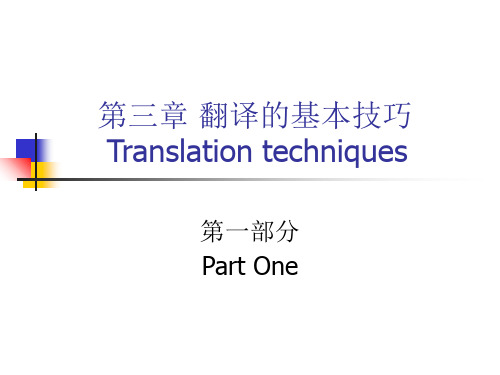
他进入哈佛大学的机会微乎其微。
His new car made him the envy of every boy in the neighborhood.
他有一辆新车,为此他成了邻里男孩们羡慕的对象。
At 22, he had first learned what it is to be a negro.
3. Some reporters who were not included in the session broke the story.
4. He’ll be very happy if that story holds up.
5. The Rita Hayworth’s story is one of the saddest.
各国社会制度的不同,不应妨碍彼此接近和相互合作。
He caught the ball with his left hand.
他用左手接球。
Doctors have said that they are not sure they can save his life.
医生说他们不敢肯定能否救得了他的命。
To them, he personified absolute power.
在他们看来,他就是绝对权力的化身。
Satellites, however, must be closely watched, for they are constantly being tugged by the gravitational attraction of the sun, moon and earth.
advice 忠告 advices 通知
color 颜色 colors 颜色、旗帜
根据词的搭配确定词义p.35 by means of collocation
His new car made him the envy of every boy in the neighborhood.
他有一辆新车,为此他成了邻里男孩们羡慕的对象。
At 22, he had first learned what it is to be a negro.
3. Some reporters who were not included in the session broke the story.
4. He’ll be very happy if that story holds up.
5. The Rita Hayworth’s story is one of the saddest.
各国社会制度的不同,不应妨碍彼此接近和相互合作。
He caught the ball with his left hand.
他用左手接球。
Doctors have said that they are not sure they can save his life.
医生说他们不敢肯定能否救得了他的命。
To them, he personified absolute power.
在他们看来,他就是绝对权力的化身。
Satellites, however, must be closely watched, for they are constantly being tugged by the gravitational attraction of the sun, moon and earth.
advice 忠告 advices 通知
color 颜色 colors 颜色、旗帜
根据词的搭配确定词义p.35 by means of collocation
英译汉翻译技巧必看PPT课件
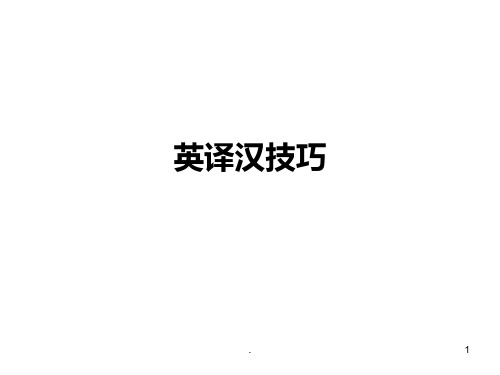
• 他三岁丧父,所以记不起父亲了。
• Strange enough they were the same age to the day.
• 说来也巧, 他俩年纪一样大, 而且还是同 日的。
.
15
5.合译法
• 合译是将原文的两个或几个分开叙述的意 思或层次合并重组,如将两个分句合译为 一个简单句,或两个简单句合译成一个复 合句等, 使全句的结构更加紧凑,语气更 加顺通。
• 直译: 好的婚姻不会仅仅发生—它们需要 大量的爱和大量的工作。
• 意译:幸福的婚姻不是凭空发生的---它需 要你为它付出大量的爱和做大量的工作。
• 或:美满的婚姻不会从天上掉下来---你必 须为它付出大量的爱,做大量的工作。
.
5
• 很显然,本句话的意译要比直译更符合汉 语表达习惯。当然,一句话并不限于一种 译法,要根据具体需要而定。一般来说, 在英汉翻译考试中,如果直译能达意就用 直译,如果直译效果不好,就应该考虑意 译。只要译文内容忠实,意思明白就行了。
• The electronic computer is chiefly characterized by its accurate and rapid computation.
• 计算机的主要特点是计算准确迅速。
.
21
3.英语名词→汉语形容词
• 英语原文中有形容词加后缀构成的名词, 翻译时可转化为汉语的形容词。 如:
• He came to my home for help. • 他来到我家请求帮助。 • I love having Friday off. • 我喜欢周五休息。 • I am for the former. • I am against the latter.
• Strange enough they were the same age to the day.
• 说来也巧, 他俩年纪一样大, 而且还是同 日的。
.
15
5.合译法
• 合译是将原文的两个或几个分开叙述的意 思或层次合并重组,如将两个分句合译为 一个简单句,或两个简单句合译成一个复 合句等, 使全句的结构更加紧凑,语气更 加顺通。
• 直译: 好的婚姻不会仅仅发生—它们需要 大量的爱和大量的工作。
• 意译:幸福的婚姻不是凭空发生的---它需 要你为它付出大量的爱和做大量的工作。
• 或:美满的婚姻不会从天上掉下来---你必 须为它付出大量的爱,做大量的工作。
.
5
• 很显然,本句话的意译要比直译更符合汉 语表达习惯。当然,一句话并不限于一种 译法,要根据具体需要而定。一般来说, 在英汉翻译考试中,如果直译能达意就用 直译,如果直译效果不好,就应该考虑意 译。只要译文内容忠实,意思明白就行了。
• The electronic computer is chiefly characterized by its accurate and rapid computation.
• 计算机的主要特点是计算准确迅速。
.
21
3.英语名词→汉语形容词
• 英语原文中有形容词加后缀构成的名词, 翻译时可转化为汉语的形容词。 如:
• He came to my home for help. • 他来到我家请求帮助。 • I love having Friday off. • 我喜欢周五休息。 • I am for the former. • I am against the latter.
汉英翻译翻译技巧PPT课件

get cold feet 胆怯
mend one's fences 改善关系
谦虚态度 modesty 发展过程 development
稳定性 stability
灵敏性 sensibility
无知的表现 innocence 同情心理 sympathy
鸡毛蒜皮 trifling
单枪匹马 all by oneself
LOG原文中抽象或者比较抽象的单词、词组、 成语或句子用具体或者是比较具体的单词、词组、成语或者句 子来进行翻译,从而消除或降低语言差别给翻译带来的损失。
如:transportation 运输工具 translation 翻译作品
advertisement 广告资料 government 政府官员
LOGO
在翻译过程中把原文中抽象或者比较抽象的单词、词组、
成语或句子用具体或者是比较具体的单词、词组、成语或者句 子来进行翻译,从而消除或降低语言差别给翻译带来的损失。
如: 大吵大闹 raise the roof 公开认错 stand in the white sheet 有花不完的钱 have enough money to burn 话中有话 with the tongue in the cheek 机敏 keep one's eyes on the ball 坚决反对 put one's foot down; set one's face against 截然不同 oil and vinegar 鲁莽的人 a bull in a china shop 告发 put the finger on 甘苦差事 hold (carry) the baby 反应快 think on one's feet 保密 keep sth under one's hat
英语翻译技巧 转译法 22页PPT文档

• 她的脱险可以说是个奇迹。
• Negation(un-,in-,dis-…) ----译文多为肯定形式(反说正译)
• I regret to learn that you have failed in the examination.
• 得知你未通过考试,深表遗憾。
• Water is a good lubricant, if you can devise a way to keep it from leaking out or evaporating.
English: ‘Did you have a good trip?’ word-for-word translation ‘You must have had a
tiring journey’ (the English-speaking people seldom say that.)
All that glitters is not gold. 发光的不一定都是金子。
• --Will you go out with me this Saturday? --I guess I am having a headache this
• Don’t stop working,” he said. • 他说,“继续干吧。”
• There’s scarcely an aspect of our life that isn’t being upended by the torrent of information available on the hundreds of millions of sites crowding the Internet.
• There has been serious disagreement between the two political parties over this question.
• Negation(un-,in-,dis-…) ----译文多为肯定形式(反说正译)
• I regret to learn that you have failed in the examination.
• 得知你未通过考试,深表遗憾。
• Water is a good lubricant, if you can devise a way to keep it from leaking out or evaporating.
English: ‘Did you have a good trip?’ word-for-word translation ‘You must have had a
tiring journey’ (the English-speaking people seldom say that.)
All that glitters is not gold. 发光的不一定都是金子。
• --Will you go out with me this Saturday? --I guess I am having a headache this
• Don’t stop working,” he said. • 他说,“继续干吧。”
• There’s scarcely an aspect of our life that isn’t being upended by the torrent of information available on the hundreds of millions of sites crowding the Internet.
• There has been serious disagreement between the two political parties over this question.
《英译汉翻译技巧》课件

翻译的标准和原则
忠实原文:准确传达原文的意思和情感 通顺流畅:译文要通顺流畅,符合目标语言的语法和表达习惯 符合文化背景:译文要符合目标语言的文化背景和表达习惯 保持原文风格:译文要尽量保持原文的风格和特点
翻译的过程和方法
理解原文:理解原文的意思和语境 分析原文:分析原文的语法、结构和词汇 翻译原文:将原文翻译成目标语言 检查译文:检查译文的语法、结构和词汇是否正确 修改译文:根据原文和译文进行修改和调整 校对译文:对译文进行校对,确保译文的准确性和流畅性
实际案例分析与实践
案例一:翻译技巧在商 务信函中的应用
案例二:翻译技巧在科 技文献中的应用
案例三:翻译技巧在文 学作品中的应用
案例四:翻译技巧在旅 游指南中的应用
案例五:翻译技巧在广 告宣传中的应用
案例六:翻译技巧在法 律文件中的应用
翻译练习与点评
翻译练习:选择一段英文材料进行翻译,如新闻、小说、科技文献等 翻译技巧:运用词汇、语法、句型等翻译技巧进行翻译 点评:对翻译结果进行点评,包括准确性、流畅性、文化差异等方面 改进建议:根据点评结果,提出改进建议,提高翻译质量
文化背景与语篇意义
文化背景:了解源语言和目标语言的文化差异,以便更好地理解原文和翻译 语篇意义:理解原文的语篇结构和意义,以便更好地进行翻译 语境:考虑原文的语境,以便更好地理解原文和翻译 翻译策略:根据原文的语境和文化背景,选择合适的翻译策略,如直译、意译、增译、减译等
语篇风格与翻译处理
语篇风格:包括正式、非正式、口语化等 翻译处理:根据语篇风格选择合适的翻译策略 正式语篇:使用正式、规范的语言,避免口语化表达 非正式语篇:使用非正式、口语化的语言,增加亲切感 口语化语篇:使用口语化的表达方式,使翻译更贴近原文风格
Translation-techniques(里面包含增译法-减译法-转译法-重复译法)PPT课件
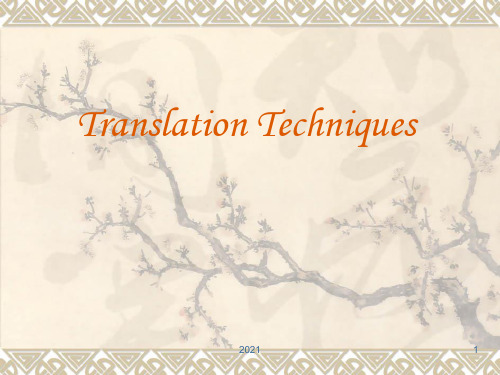
2021
14
Examples
❖ We have to analyze and solve problems. ❖ 我们要分析问题,解决问题。
❖ Let’s revise our safety and sanitary regulations. ❖ 我们来修改安全规则和卫生规则吧。
❖ Gentlemen may cry, peace, peace --- but there is no peace.
2021
13
1. Repetition(重复法)
❖ 他老是磨磨蹭蹭,马马虎虎,脾气又好得惊人,我们都对他 毫无办法。
❖ With his tardiness, careless and appalling good temper, we had nothing to do with him.
❖ 我的回答完全是坦坦荡荡,(直言无隐),不藏不掖。
2பைடு நூலகம்21
6
III. Introduction to the techniques of translation
❖ Techniques of translation refer to the experience that people have accumulated in their practice of translation. They include lots of skills in translation, such as selection of word meaning, extension of word meaning, conversion of parts of speeches and sentence structures, long sentence translation, paragraph and passage translation, translation of articles of different kinds of styles, etc.
大学英语-翻译课件-Translation_Techniques_1_Amplification

What are the Eight translation skills?
1) conversion 2) division 3) inversion 4) negation 正说反译法, 反说正译法 5) amplification 6) omission 7) the change of voices 8) repetition
译文一:她觉得手里和唇上都是花儿,胸中 也生长着花儿。
译文二:她觉得她好像手里拿着花,嘴里吻 着花,连胸中也生出了花。
In the evening, after the banquets, the concerts and the table tennis exhibitions, he would work on the drafting of the final communiqué.
II. Classification of Amplification
I Lexical Amplification(从词汇上考虑的增词)
This kind of amplification includes: amplification by supplying such kinds of words as verbs, nouns, adjectives, adverbs, numerals, category words, generalization words, and the plural forms of nouns. These kinds of words are amplified so that they can express the intended or implied lexical or contextual meanings of the SL text clearly and exactly, or in other words, they are amplified so as to make the implied lexical meanings in the SL text concrete, clear, and idiomatic.
Chapter 5 Translation techniques (II)47页PPT

• 营业利润基本维持在21亿3000万瑞典克朗, 而去年同期为21万瑞典克朗. 沃尔沃期望今年 在生产方面至少能增益5%
• The group’s liquid funds, inflated by the record profits of the past two years, climbed to eighteen point two five billion Swedish kronor by the end of the first quarter from fourteen point four billion Swedish kronor a year earlier.
重复动词
• We talked of ourselves, of our prospects, of the journey, of the weather, of each other— of everything but our host and hostess.
• 我们谈到自己,谈到前途,谈到旅程,谈 到天气,谈到彼此的情况——谈到一切, 只是不谈我们的男女主人。
• 尽管其汽车的销售量有了大幅度的增长, 沃尔沃的营业额却下跌了5%,从去年前三 个月的218亿瑞典克朗下降到206亿瑞典克 朗。
• Turnover: the total business done by an organization in a given period.
• 营业额,成交量
• An annual turnover of $10 million. • 全年营业额1,000万美元。
• 财经项目的利润增长达到24.5亿瑞典克朗(3 亿1500万美元),而去年同期则为22.1亿瑞典 克朗。
• The group was helped by a two hundred and fifteen million Swedish kronor foreign-exchange gain on loans—compared with a gain of thirty million Swedish kronor a year earlier—as well as by interest earnings of a hundred and nine million Swedish kronor—compared with seventy-seven million Swedish kronor in the first quarter of last year.
• The group’s liquid funds, inflated by the record profits of the past two years, climbed to eighteen point two five billion Swedish kronor by the end of the first quarter from fourteen point four billion Swedish kronor a year earlier.
重复动词
• We talked of ourselves, of our prospects, of the journey, of the weather, of each other— of everything but our host and hostess.
• 我们谈到自己,谈到前途,谈到旅程,谈 到天气,谈到彼此的情况——谈到一切, 只是不谈我们的男女主人。
• 尽管其汽车的销售量有了大幅度的增长, 沃尔沃的营业额却下跌了5%,从去年前三 个月的218亿瑞典克朗下降到206亿瑞典克 朗。
• Turnover: the total business done by an organization in a given period.
• 营业额,成交量
• An annual turnover of $10 million. • 全年营业额1,000万美元。
• 财经项目的利润增长达到24.5亿瑞典克朗(3 亿1500万美元),而去年同期则为22.1亿瑞典 克朗。
• The group was helped by a two hundred and fifteen million Swedish kronor foreign-exchange gain on loans—compared with a gain of thirty million Swedish kronor a year earlier—as well as by interest earnings of a hundred and nine million Swedish kronor—compared with seventy-seven million Swedish kronor in the first quarter of last year.
- 1、下载文档前请自行甄别文档内容的完整性,平台不提供额外的编辑、内容补充、找答案等附加服务。
- 2、"仅部分预览"的文档,不可在线预览部分如存在完整性等问题,可反馈申请退款(可完整预览的文档不适用该条件!)。
- 3、如文档侵犯您的权益,请联系客服反馈,我们会尽快为您处理(人工客服工作时间:9:00-18:30)。
e.g. No smoking(禁止吸烟)
Stylistic Meaning: is communicated of the social circumstance of language use.
Linguistic Meaning: is built on the relationships of the signs with each other in the same system.
1.Diction(遣词用字) 2.Repetition(重译法) 3.Amplification(增译法) 4.Omission(减译法) 5.Conversion(转换法) 6.Inversion(词序调整法) 7.Negation(正说反译,反说正译法) 8.Change of Voices(语态变换法) 9.Division(分译法) bination(合译法)
•
Combination(合并法)
•
Pictographic(图形法)
•
Transliteration(音译法)
•
Zero-Translation(零翻译法)
•
Transliteration + Explanation(音义结合法)
Definition of amplification
Diction is one of the basic translation techniques to express meaning by using the proper choice of words and phrases. It must be based on the accurate comprehension of the original.
•
Choice of Contextual Meanings
➢
Special Techniques Employed in Translating a word.
•
Deduction(推演法)
•
Transplant(移植法)
•
Extension(引申法)
•
Substitution(替换法)
•
Explanation(释义法)
1) Frozen(拘谨) 2) Formal(正式) 3) Consultative(商议) 4) Casual (随意) 5) Intimate (亲密)
6) For example:
7) Linguistic Terms
8)
Frozen Formal Consultative Casual Intimate
e.g. 大家见面,招呼声“吃了吗?”透着和气。 They greet with each other with a “Hi” just to show their
good neighbourly feelings. 年夜饭
family reunion meal on the eve of the Spring Festival.
4) Take “wife” for instance: Colloquial: woman, old woman, better half Common: wife Formal: consort, spouse, helpmate.
英汉互译简明教程
Translation Techniques
Generally speaking, the basic translation techniques that merit our attention and are to be applied in English-Chinese or ChineseEnglish translations include:
4.1 Diction
Teaching Contents:
Word Meaning
•
Conceptual Meaning
•
Stylistic Meaning
•
Linguistic Meaning
•
Pragmatic Meaning
Choice of Word Meanings
•
Choice of Word Meanings According to Their Parts of Speech
• There are different views on classification of levels of formality of words, and Martin Joos classifies this into five categories in his paper “Five Clocks” as follows:
e.g. 千山鸟飞绝,From hill to hill no bird in fight. 万径人踪灭。From path to path no man in sight.
Pragmatic Meaning: is the study of the “relation of signs to interpreters”.
Speaking of word meanings ,there are conceptual meaning, stylistic meaning, linguistic meaning and pragmatic meaning.
Word Meanings
Conceptual Meaning: is the basic meaning and the main information carried by linguistic signs.
Sample Words Quaff Imbibe Drink Swig Guzzle
• In practice, words are actually classified into
three categories as :
1) colloquial(口语) 2) 2)common (常用语) 3) 3)foice of Word Meanings According to Different Collocation.
•
Choice of Meaning Shifts Between the Abstract and the Concrete.
•
Choice of Affective Meanings.
Stylistic Meaning: is communicated of the social circumstance of language use.
Linguistic Meaning: is built on the relationships of the signs with each other in the same system.
1.Diction(遣词用字) 2.Repetition(重译法) 3.Amplification(增译法) 4.Omission(减译法) 5.Conversion(转换法) 6.Inversion(词序调整法) 7.Negation(正说反译,反说正译法) 8.Change of Voices(语态变换法) 9.Division(分译法) bination(合译法)
•
Combination(合并法)
•
Pictographic(图形法)
•
Transliteration(音译法)
•
Zero-Translation(零翻译法)
•
Transliteration + Explanation(音义结合法)
Definition of amplification
Diction is one of the basic translation techniques to express meaning by using the proper choice of words and phrases. It must be based on the accurate comprehension of the original.
•
Choice of Contextual Meanings
➢
Special Techniques Employed in Translating a word.
•
Deduction(推演法)
•
Transplant(移植法)
•
Extension(引申法)
•
Substitution(替换法)
•
Explanation(释义法)
1) Frozen(拘谨) 2) Formal(正式) 3) Consultative(商议) 4) Casual (随意) 5) Intimate (亲密)
6) For example:
7) Linguistic Terms
8)
Frozen Formal Consultative Casual Intimate
e.g. 大家见面,招呼声“吃了吗?”透着和气。 They greet with each other with a “Hi” just to show their
good neighbourly feelings. 年夜饭
family reunion meal on the eve of the Spring Festival.
4) Take “wife” for instance: Colloquial: woman, old woman, better half Common: wife Formal: consort, spouse, helpmate.
英汉互译简明教程
Translation Techniques
Generally speaking, the basic translation techniques that merit our attention and are to be applied in English-Chinese or ChineseEnglish translations include:
4.1 Diction
Teaching Contents:
Word Meaning
•
Conceptual Meaning
•
Stylistic Meaning
•
Linguistic Meaning
•
Pragmatic Meaning
Choice of Word Meanings
•
Choice of Word Meanings According to Their Parts of Speech
• There are different views on classification of levels of formality of words, and Martin Joos classifies this into five categories in his paper “Five Clocks” as follows:
e.g. 千山鸟飞绝,From hill to hill no bird in fight. 万径人踪灭。From path to path no man in sight.
Pragmatic Meaning: is the study of the “relation of signs to interpreters”.
Speaking of word meanings ,there are conceptual meaning, stylistic meaning, linguistic meaning and pragmatic meaning.
Word Meanings
Conceptual Meaning: is the basic meaning and the main information carried by linguistic signs.
Sample Words Quaff Imbibe Drink Swig Guzzle
• In practice, words are actually classified into
three categories as :
1) colloquial(口语) 2) 2)common (常用语) 3) 3)foice of Word Meanings According to Different Collocation.
•
Choice of Meaning Shifts Between the Abstract and the Concrete.
•
Choice of Affective Meanings.
